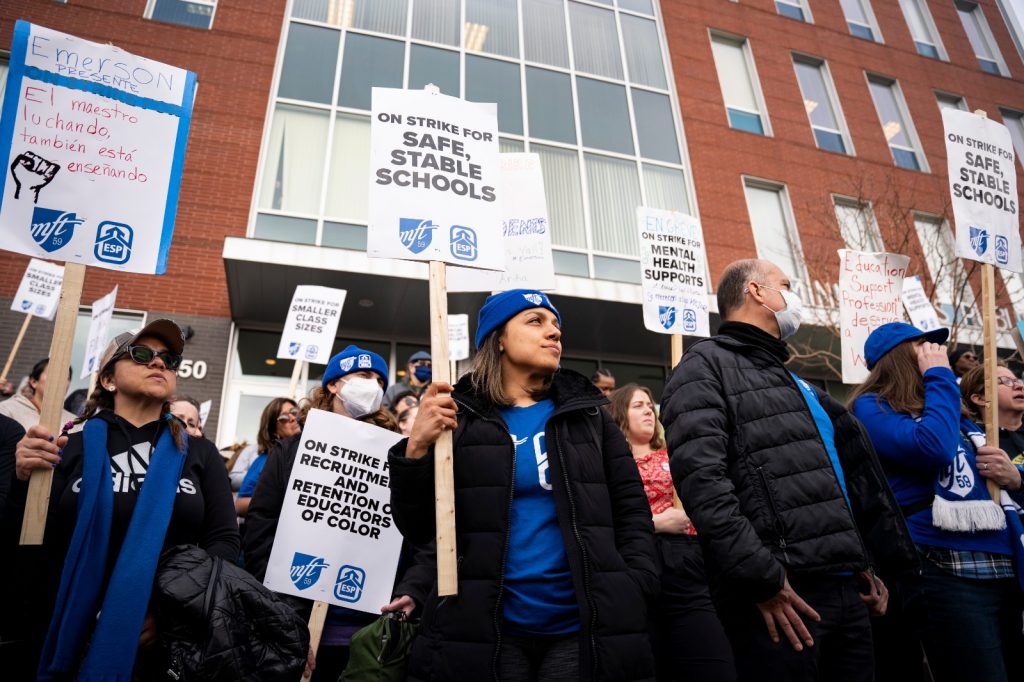A note from the authors: We spent almost every day in the streets together with Minneapolis teachers and students and would like to thank the teachers and students who shared their thoughts and opinions with us. As you all return to work, we offer these reflections on the strike. We also want to highlight your voices. Left Voice opens our pages, not only to discuss the next Minneapolis teachers’ contract, but also as a source of learning and organizing for other educators’ struggles around the country. If you have suggestions or would like to contribute, [email protected].
In Minneapolis, the first teachers and Education Support Professionals (ESPs) strike in 50 years ended on Sunday night when the tentative agreement was ratified by teachers. For almost three weeks, thousands of educators and students showed up every weekday morning at 7:30 am to join picket lines at every public school across Minneapolis. Some arrived earlier, bringing signs, megaphones, and tables that quickly filled with coffee, snacks, fruits, hand warmers, and, occasionally, a special breakfast. Most items were donated by parents and community members who stopped by the picket lines after honking in support from the road.
Despite freezing temperatures, rain, and snow the striking educators remained enthusiastic. Sometimes bands were playing; sometimes teachers danced and chanted. Later in the day, teachers by the thousands marched in rallies and protests all over Minneapolis, including to the capitol, downtown Minneapolis, and the Governor’s mansion.
It was never easy. But these teachers, backed by students and the community, were strong, vibrant, and united. For most, this was their first experience of a strike, and their first time joining a picket line. Each school chose strike captains, and often organized separate GoFundMe pages to make sure they could hold the line. In many schools, teachers would gather in a circle to check in with each other, and organize groups of teachers to march around the neighborhood, go to more visible areas, or unite with other schools. These spaces had a huge potential to develop into sites of self-organization where workers could discuss and vote on next steps for the struggle.
Again and again, the teachers emphasized: they were fighting not just for raises, but for better learning conditions for their students: smaller class sizes, guidance counselors, mental health support, and the recruitment and retention of BIPOC educators. And, importantly, they were striking in solidarity with Minneapolis’s Educational Support Professionals (ESPs) who are overwhelmingly people of color, who are paid much lower wages.
This struggle was deeply informed by the Black Lives Matter movement, and was in some respects a continuation of that movement, which began in Minneapolis when the police murdered George Floyd. As Left Voice recently pointed out, the cops not only murdered George Floyd in a video seen by every Minneapolis student; they brutalized protesters. Minneapolis activist and Left Voice member Adnan Ahmed writes, “During the Derek Chauvin trial, which coincided with the police murder of Daunte Wright, community members were once again brutalized with tear gas and rubber bullets, and the Twin Cities were crawling with National Guard. Against this backdrop, it comes as no surprise that the teachers who do the labor of nurturing the younger members of our society are on strike for racial justice. All of their demands are directly connected to the Black struggle.”
The Approved Contract
Teachers ratified their contract with a yes vote of 80 percent, while the ESP contract passed with just 76 percent of the vote. The contracts include some gains, but the results are far short of what these educators demanded and deserve. Among the main shortcomings is the fact that teachers will see just a 2 percent pay raise in the first year, and 3 percent raise in the second year of the two-year contract. This is unmistakably a pay cut, since seasonally adjusted inflation rose 7.9 percent over the last 12 months alone. Educational Support Professionals (ESP’s) are getting raises between $2 – $4, but that doesn’t even guarantee the already very low baseline of $35,000 salary for all ESPs.
The contract does include caps in class sizes, but the cap is set at an astonishingly high 44 students per classroom for high schools. In some cases, co-teaching models are being proposed as an alternative to lower class sizes, which especially affects English Learner (more commonly known as ESL) teachers. While the new contract takes some steps towards promoting and defending positions for BIPOC educators, it includes language that accepts layoffs as a given. In our view, layoffs should always be challenged.
The tentative agreement comes alongside a “Return to Work Agreement.” This agreement includes 45 minutes extra per day, and 15 extra work days for the rest of the school year to make up the time lost during the strike. This doesn’t just increase the burden on educators; it also affects parents, who will have to readjust their schedules, and means significantly less time off for students. Many educators believe this is a collective punishment for having dared to challenge the corrupt Minneapolis Public School (MPS) administration.
Finally, the voting process was deeply undemocratic. The more than 4,000 educators only received the TA on Friday night, while the voting started on Saturday morning and ended on Sunday at 4pm. Meanwhile, the district began calling families and teachers, claiming the strike was over before most teachers could see, much less read, the agreement. This was a calculated campaign to pressure teachers into accepting the contract. Despite widespread disappointment with the contract, the tactic worked.
Attacks on Public Education in a Blue State
Many think Republicans alone are the enemies of the working class that want to cut funding from public schools. But Minneapolis shows that this agenda is bipartisan. Minnesota is a blue state, and Minneapolis a deeply and historically blue city: a Democratic governor, a Democratic mayor, a Democratic school board, and a Democratic city council. These Democrats have overseen the gutting of Minneapolis public schools, and now a sub-par contract for striking educators. It’s these Democrats who just passed a police budget that includes wage increases and $7K bonuses for the police. Yet these same Democrats claim there’s no funding for educators.
The Democrats running Minneapolis public schools have privatized public education by expanding predatory charter schools. They have invited a “partnership” with the Minneapolis Foundation, a “non-profit” led by former Democratic Mayor of Minneapolis R.T. Rybak, which seeks to privatize public education and crush teachers’ unions.
And, even now, the school is signaling that this sub-par contract will be paid for with punitive austerity measures. Superintendent Ed Graff, who makes $230,000 a year, said “The contracts we have put forward are going to require us to take a look at our budgets going forward.”
Even the “progressive” Democrats, who one might think would support the teachers, did little or nothing to support the strike fund or increase the strike’s visibility. The cozy relationship between the Minnesota Democratic–Farmer–Labor Party and Minnesota union leaders means that they can still count on union support, even after they didn’t lift a finger in support of the strike.
You may be interested in: No Money for Educators, but Minnesota Funds the Police
Where Was the AFT?
Despite massive support for the strike within Minneapolis, and a fighting spirit among teachers and supporters, the strike remained isolated. A near-total media blackout meant the strike went practically unnoticed outside of Minnesota; even many progressive and labor-focused outlets were inexplicably and inexcusably silent on the strike. This isolation surely emboldened the district in forcing the sub-par contract on teachers.
Furthermore, teachers were pressured into accepting the first TA by the fact they were already going without a paycheck, and on April 1, they would have lost their health insurance. For many teachers with medical conditions or with family members who rely on that insurance, this would be very difficult.
But there was no reason for the Minneapolis strike to be so isolated; teachers’ unions are among the biggest and best-funded in the country. The American Federation of Teachers (AFT) is worth over 500 million dollars and regularly donates millions to the Democratic Party. While the AFT donated 100,000 to the Minneapolis teachers, this is clearly not enough.
With over 1.6 million members, the AFT could have sent a clear message: we will make sure the strike fund allows all teachers to stay out; we will cover teachers’ health insurance; and we will make sure you have what you need to stay on strike. The AFT could have organized national solidarity with Minneapolis teachers; after all, every teacher in the country knows firsthand the struggles of their colleagues in Minneapolis. That’s why teachers went on strike in 2018 and 2019 in West Virginia, Oklahoma, Arizona, Chicago, LA, Oakland and more. And conditions have only gotten worse in the pandemic. Half of U.S. teachers are considering quitting their jobs. The union could have organized a day of solidarity to build the strike fund, could have taken to the streets, could have brought attention to the strike. They could, and should have, built a national movement — first Minneapolis, then the rest of the country’s teachers, fighting for safe and stable schools.
You may be interested in: Unions Around the Country Must Go All Out for Teachers in Minneapolis
But it’s not just the AFT. Education Minnesota (EM) is the biggest union in Minnesota, representing 90,000 educators. While the EM president Denise Specht showed up at the picket lines, four days before the strike started, Education Minnesota endorsed Governor Tim Walz for reelection, citing his “unwavering support of students and their educators.” The conditions of Minneapolis schools, and his silence and lack of support for the strike, puts the lie to this: Tim Walz is sitting on a $9 billion surplus, but has done nothing to share this bounty with the educators he extolls as “essential.”
Our unions should not be funding streams for the Democratic Party– the very party Minneapolis teachers were on strike against; they should be fighting forces that go all out for teachers in struggle.
We Need To Expand Union Democracy
Throughout most of the three weeks on strike, teachers were kept in the dark about how negotiations were going. Union representatives would make short videos in the morning, but the offers and counter-offers were never made public. There was simply no structure for educators to weigh in on negotiations, or follow the process as it was happening.
You may be interested in: International Solidarity with Minneapolis Teachers Strike
It’s to be expected that the district would use procedural maneuvers and other tactics to limit access to negotiations, but workers and our unions must reject this completely. Unfortunately, that wasn’t the attitude of the bargaining team. As one member of the bargaining team explained: “We haven’t been as open, we are not putting as much information, because traditionally mediation is not public and we decided to kind of stand in that for a while because you know we made a commitment to the district that we would be respectful of that rule.”
Bargaining should include all the membership; not just updates, but access to the daily negotiations. In future struggles, teachers should fight for open bargaining — so that any teacher can watch the negotiations and have access to the most complete and current information. This information should also be discussed on picket lines and at rank-and-file meetings, so that every worker can discuss and decide about the best steps for the struggle to take. Not only would this ensure healthier discussions, it would also have helped to expose and counter the awful behavior of the district’s negotiators, who walked out of negotiations and sometimes refused to even show up.
Teachers were put in an impossible position –- before the tentative agreement was even released to teachers on Friday, the district was calling families to say school would begin on Monday. By Saturday, teachers were expected to start voting, without sufficient time or space to discuss, debate and decide. The union actively campaigned for a “yes” vote on the TA, putting out videos of educators explaining their reasoning behind voting yes. No such space is made for teachers who want to vote no. This isn’t democratic — workers need to hear from both sides.
Preparing for the Contract Struggle in Two Years
A new generation of activists were formed in this strike. Teachers who had never gone on strike suddenly experienced their strength as workers on the picket line. As one teacher told Left Voice: “I’ve never felt so powerful”.
During the strike, hundreds of students showed up to the picket lines, rallies, and marches in support of their teachers and ESPs. But they also organized their own protests, like the three-day sit-in at the Davis Center, where the contract negotiations were conducted. While the district said that students were deprived of learning because of the strike, their experiences supporting their teachers and ESPs are lessons in struggle they will not soon forget.
These students and these teachers, many of whom protested in the Black Lives Matter movement, are a new generation of activists who will play a role in the battles to come — beginning with the fight many educators are already talking about: the contract negotiation in 2024.
Although most educators voted “yes” for the contract, most aren’t necessarily happy with it. Most who voted in favor acknowledged the shortcomings of the contract, but felt that they didn’t have the forces or morale to continue the strike. Voting “no” could have opened a new and more radicalized chapter in this struggle — and could have secured teachers a better offer, as John Deere workers did by rejecting a TA during their strike. But, there is broad agreement that the fight to defend public education doesn’t end here, and they are already planning to arrive at the next contract negotiation better organized.
But, the hard work of this huge experience was not done in vain. Many threw themselves headlong into the strike, despite the economic sacrifices they had to make. They were convinced and brave, and they are a source of inspiration.
Towards a National Teachers Movement
The fact that public education exists is a victory of the working class who fought for it. But public schools have been attacked, eroded and defunded by capitalists, especially under the neoliberal austerity of the past few decades. Teachers around the country have had enough. This is the reason teachers led a 2018 strike wave, and it’s the reason that Sacramento teachers are currently on strike.
But neoliberal austerity measures are hardly the only threat teachers face. Recently, schools have been the nexus for racist attacks on the teaching of history and renewed offensive against LGBTQ+ youth. Students walked out against “Don’t Say Gay,” as did Disney workers. Teachers have a role to play in this struggle too.
The Minneapolis teachers’ strike highlighted how teachers can take up and strike for community demands and demands from the Black Lives Matter movement. As right-wing attacks on teachers continue, it is all the more urgent for teachers to fight for community demands and demands of the most oppressed.
The forces aligned against public education, against oppressed students, and against teachers are enormous, which is why the fight cannot be left up to one local union. Instead, we need the full support of national unions and unions from diverse industries. We need unions that are not proxies for the same Democratic Party the teachers were striking against, but are actually fighting tools for teachers and workers all over the country. That means that teachers cannot rely on union leadership for all decision making and organization; struggles, strikes, and everyday decision making must be based in democratically self-organized bodies where strikers can discuss and vote regularly on their demands, priorities, and the steps to follow.
As a teacher from Emerson Immersion School said, “In these past years, you can feel the weight of capitalism a lot. But in our struggle and joy, I found a new energy. I believe this strike changed me forever.”
This is only the first chapter in the struggle.












